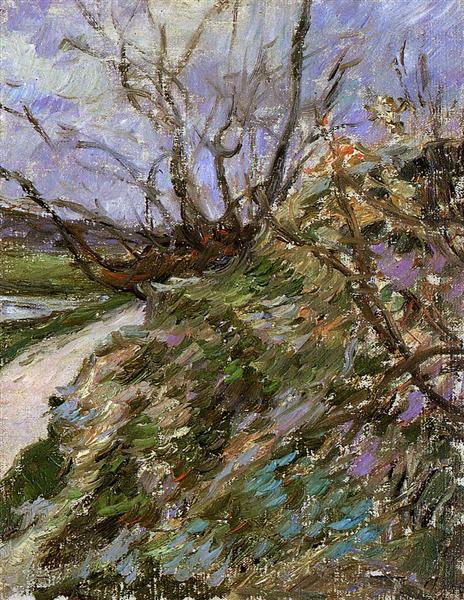Description
Paul Gauguin's Riverbank in Winter (1881) is a fascinating example of the artist's transition into a post-impressionist style that sought to capture not only the visual representation, but also an emotional and symbolic experience of the landscape. In this piece, the cold winter atmosphere is manifested through a soft, cool color palette that reinforces the feeling of a grey, overcast day, inviting the viewer to contemplate the stillness and isolation that the colder months of the year evoke.
The composition is structured with careful attention to balance and harmony. The river, which gently meanders across the horizon, acts as a central element that guides the viewer's gaze. To the left, we can see a strip of bushes and vegetation that are in their winter phase, reinforcing the theme of the landscape during this season. The arrangement of the trees, with their bare, leafless branches, suggests a desolation that is accentuated by the mist that seems to envelop the surroundings.
One of the most intriguing aspects of this work is the way Gauguin uses colour. The combination of grey, blue and brown tones creates a melancholic atmosphere, characteristic of winter. However, hints of other, more vibrant colours, such as yellow and red, can also be detected framing some elements of the landscape. These brushstrokes contradict the overall cold palette, suggesting that, despite the winter, there is a latent life waiting to be reborn in the spring.
It is relevant to note that the artist, who had moved to Pont-Aven in Brittany, began to explore a more personal and introspective approach in his landscapes, moving away from the purely naturalistic approach of Impressionism towards something more symbolic and emotional. In this work, there are no visible human figures, which provokes in the viewer a feeling of solitude and reflection. The absence of characters allows the landscape to speak for itself, thus intensifying the viewer's connection with nature and its state of mind.
This canvas is set at a crucial moment in Gauguin's career, where his search for new forms of expression led him to experiment with different styles and techniques. The work can be seen as a precursor to his more celebrated works in Tahiti, where colour and form became powerful expressive tools. In the broader context of Post-Impressionist art, Riverbank in Winter not only reflects Gauguin's mastery of the technique of oil painting, but also establishes a bridge between Impressionism and later explorations of Symbolism and Modernism.
In conclusion, Paul Gauguin's Riverbank in Winter is a work rich in emotion and reflection. Through his masterful use of color and composition, Gauguin not only captures an instant of winter, but also invites the viewer on an introspective journey about nature and its connection to the world. This painting, often underrated in comparison to his more famous works, firmly establishes Gauguin as a pioneer in finding new ways to represent the human experience through nature.
KUADROS ©, a famous painting on your wall.
Hand-made oil painting reproductions, with the quality of professional artists and the distinctive seal of KUADROS ©.
Painting reproduction service with satisfaction guarantee. If you are not completely satisfied with the replica of your painting, we will refund 100% of your money.

